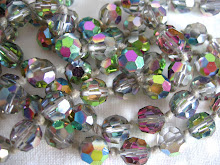Recently, I have acquired number of pieces of jewelry made of real amber. I also love amber myself, especially the Baltic amber, which is considered to be the best. From the many comments and questions I get I know that a lot of people are quite confused about different types of amber and how to be sure what you buy is indeed amber.
The most common advice is to rub a piece of amber against wool (or hair) and if it picks up a small piece of paper it is real amber. Not true. Static electricity is everywhere and if you do the same test with a piece of plastic you will get the same result. Other tests advocate floating amber beads in salty water, heating the amber until a pine smell is detected or inserting a red-hot needle into the amber piece. I don’t think I would like to do that to any of my amber jewelry.
If you are buying amber that you can actually see and touch it is little bit easier. Amber is very light and sort of warm to touch. When you handle it, it has an organic feel to it not like plastic or other resin. Look at the inclusions and ee if you can recognize any shapes, i.e. bits of leaves, pollen, wings or other parts of the insect. Smell it. If it is plastic you will smell the chemicals. Amber will not smell of anything when it is cold.
If you are buying online it is more difficult to tell from a photo so buy from a reputable source. Look out for quite obvious things like:
1) Are there many items with almost identical looking inclusions offered for sale at the same time by the same seller?
2) If the amber has inclusions do they look natural rather than staged? Any insect trapped in the amber would look distressed or broken as it would have been caught in the resin or dropped in after death. If it looks flat and carefully positioned the amber is a fake. Anything preserved in amber needs to reasonably likely be found on a conifer tree. It would be very rare to find a mouse or a frog in a piece of amber. No impossible though.
3) Are the items very cheap? If a piece of amber with a large scorpion inside is being sold for £0.99 it is definitely not genuine.
4) Do the items come from China or India? These are the two areas that most of the fake amber comes from.
If the answer is “yes” to any of these questions don’t buy.
There are other aspects to look out for.
Manufacturers of amber jewelry don’t want to waste any of this precious material Any amber that cannot be used to create a piece of jewelry, lesser quality amber and any bits and dust are collected and melted down. Artificial inclusions are added and the end mix used again. Other compounds can be added to alter the colour of the amber. Pieces of jewelry created from reconstituted amber will literary have clouds of small inclusions of all shapes or indeed none. Technically it is still amber but it is far cry from amber in its natural and original composition.
Elizabeth
